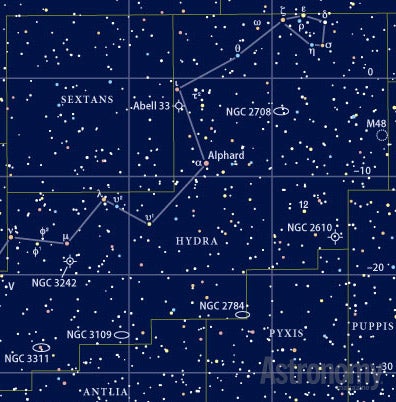Targets for April 14–21, 2016
Naked eyes: The Southern Pleiades (IC 2602)
Small telescope: The Ghost of Jupiter (NGC 3242)
Large telescope: Dwarf spheroidal galaxy Leo I
This week’s naked-eye object is for those observers in southerly latitudes. In fact, nobody who observes from north of latitude 26° north can see it. The object is the Southern Pleiades in Carina, although this open cluster also carries the designation IC 2602. And it is nothing less than dazzling.
You’ll find this open cluster surrounding the bluish magnitude 2.7 Theta (θ) Carinae, so it’s sometimes called the Theta Carinae Cluster. More commonly, however, observers call it the Southern Pleiades because its discoverer, French astronomer Nicolas Louis de Lacaille, compared it to M45. Lacaille encountered IC 2602 March 3, 1752.
The Southern Pleiades is an easy naked-eye object that shines at magnitude 1.9. It’s also large — 50′ across. As with the actual Pleiades, this object usually looks better through binoculars because most telescopes spread out the stars too much. That said, if you own a short-focal-length refractor and an eyepiece that will provide at least a 1.5° field of view, you’re in for a wonderful experience.
At low power, the Southern Pleiades appears like two clusters separated by a 0.3°-wide gulf. The western half includes Theta Carinae and two arcs of stars that originate at Theta. One arc curves northward and the other southward. The eastern half of IC 2602 looks to me like a miniature version of the main part of the constellation Orion — with different brightnesses for the stars.
When you’re satiated with the Southern Pleiades, nudge your telescope 0.7 south. There you’ll find the magnitude 8 open cluster Melotte 101. A magnification around 75x is best for this object.
A ghost you’ll enjoy seeing
This week’s small telescope target is the Ghost of Jupiter, also known as NGC 3242, which lies in the constellation Hydra the Water Snake. You’ll find the Ghost 1.8° south of magnitude 3.8 Mu (μ) Hydrae.
This is the spring sky’s showpiece planetary nebula. It shines relatively brightly at magnitude 7.8. The object received its common name, “Ghost of Jupiter,” from its planet-like appearance through small telescopes, although based on its color and brightness, NGC 3242 mostly resembles Uranus or Neptune. Sir William Herschel discovered NGC 3242 February 7, 1785.
At low magnification through a 4-inch telescope, you’ll see the Ghost’s softly glowing, pale, blue-green, 16″-diameter disk. Through larger scopes, and at powers in excess of 200x, the interior appears oval, like an eye or a football. The inner 10″ appears hollow, except for the dim central star. A faint spherical shell 40″ across encloses the “eye.” Your best bet for observing the outer shell is to use an 11-inch or larger scope, an eyepiece that provides about 100x, and a nebula filter.
Much of the Ghost’s blue-green color comes from oxygen atoms absorbing ultraviolet radiation from the central star and reradiating it as visible light. Because this emission is strong, an OIII filter works best for observing NGC 3242. “OIII” stands for “doubly ionized oxygen.” Chemists use the Roman numeral “III” to represent double ionization because they label neutral oxygen “OI.” Nebula filters such as OIII screw directly into the threaded barrels of 1¼” or 2″ eyepieces.
Easy to find, hard to see
This week’s large telescope target is dwarf spheroidal galaxy Leo I, the first object of its type in the constellation Leo the Lion.
This target is a personal favorite of mine. It demonstrates that a celestial object can be easy to find, but really difficult to observe details in. What makes Leo I easy to find is its location: It lies only 20′ due north of magnitude 1.3 Regulus (Alpha [α] Leonis). But that brilliant star’s glare through the eyepiece also makes magnitude 10.2 Leo I difficult to see.
At a dark site, an 8-inch telescope at 150x reveals a faint mist that appears uniformly bright. Whatever you do, keep Regulus out of the field of view. And remember that Leo I is large. It measures 12′ by 9.3′. That’s nearly 15 percent of the area of the Full Moon. That size makes it pretty big for a galaxy.
American astronomers Robert G. Harrington and Albert George Wilson discovered Leo I in 1950. They were searching photographic plates taken during the National Geographic Society Palomar Sky Survey using the 48-inch Samuel Oschin Schmidt Telescope.
Expand your observing at Astronomy.com
The Sky this Week
Get a daily digest of celestial events coming soon to a sky near you.
Observing Basics
Find more guidance from Senior Editor Michael E. Bakich with his Observing Basics video series.










